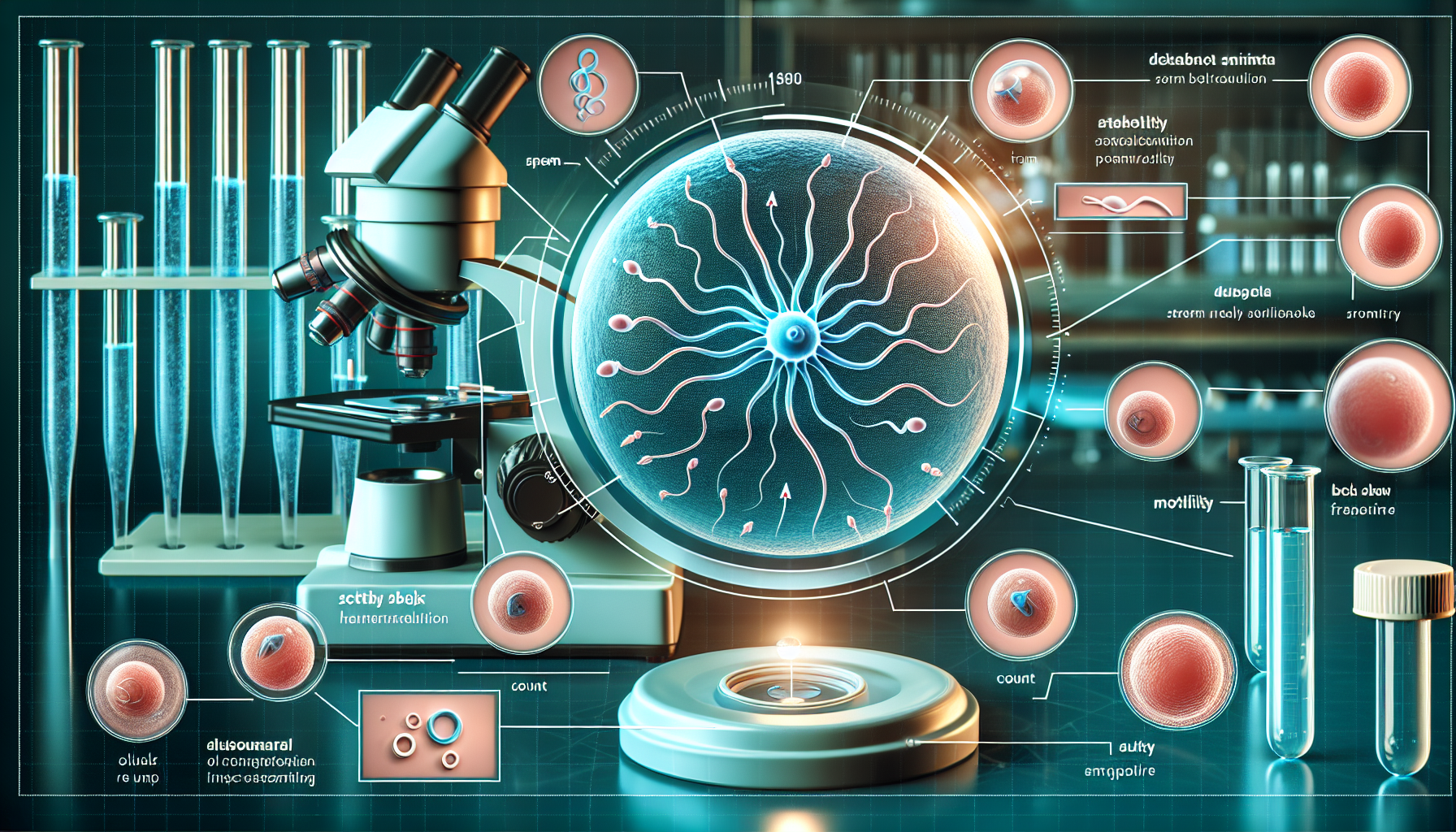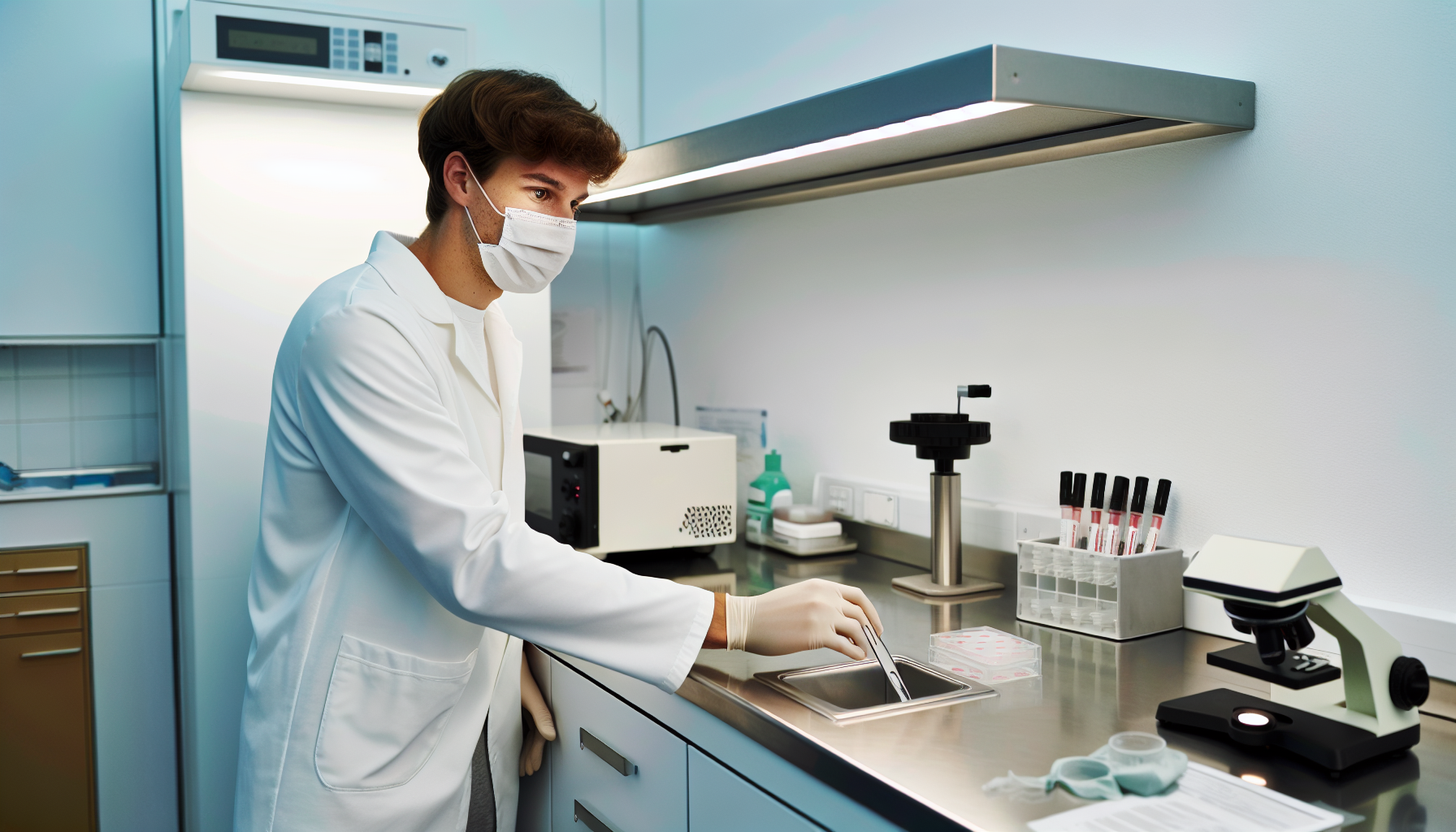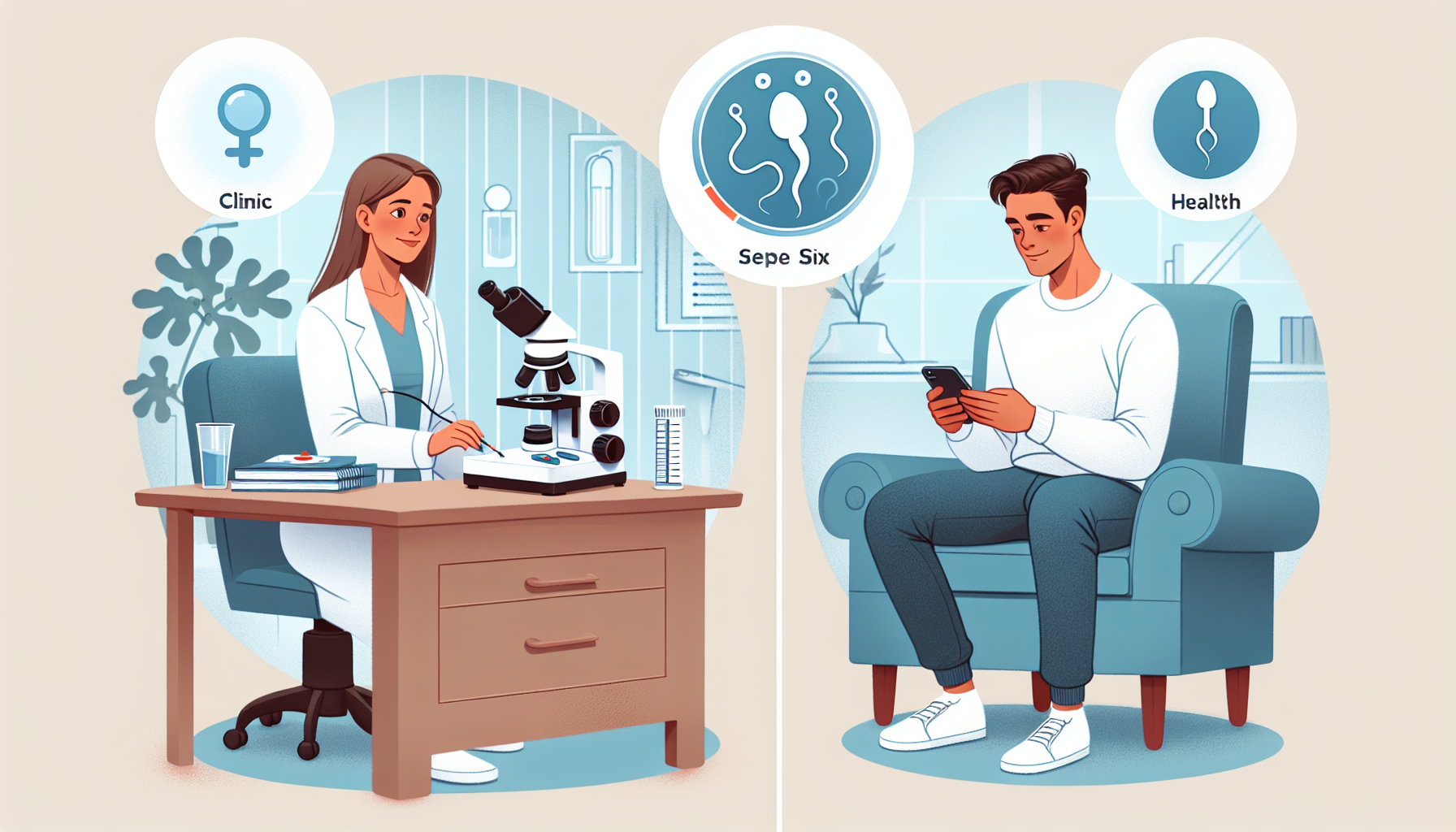Curious about how much does a sperm analysis cost? You can anticipate spending between $100 and $500. Factors like location and insurance play a role in final costs. We’ll dissect these variables and provide insights without drowning you in excess detail.
Key Takeaways
- Semen analysis costs vary widely, typically between $100-$500, influenced by location, lab selection, and insurance coverage, with some insurance plans offering partial or full coverage.
- A crucial tool for diagnosing male infertility, semen analysis assesses parameters like sperm count, motility, shape, and more, influencing treatment decisions and evaluating reproductive health.
- Alternatives to traditional in-clinic semen analysis, such as at-home sperm tests and mail-in services, offer convenience and lower costs but are less comprehensive and potentially less accurate.
The Cost of Semen Analysis

Semen analysis is a key part of the process when it comes to having children, and that raises questions regarding the financial impact. The cost of this fertility test varies depending on different elements like location, laboratory, and insurance coverage. Typically ranging from $100 to $500.
Price Range
The evaluation of human semen for fertility is done through a test called semen analysis, which costs anywhere from $100 to $500 on average in the United States. This wide range depends upon geographical disparities and operational expenses of laboratories around the country.
Factors Affecting Cost
The expenditure for semen analysis can be affected by a range of factors. For example, the type of laboratory or clinic opted for has an important impact on costs. Fertility-related labs might provide lower rates than conventional clinics which typically have charges in excess of $250. Extra tests such as sperm DNA fragmentation testing may also increase the cost further.
Insurance Coverage
The expense of semen analysis can be greatly impacted by insurance. It’s important to take into account its influence on the total expenditure. Depending on your plan, you may have partial or complete coverage for this type of diagnostic service. While some policies might not provide any compensation at all. Organizations such as Blue Cross Blue Shield, United Healthcare and TRICARE are a few among numerous US-based insurers that cover sperm testing fees.
Why Semen Analysis is Important

Semen analysis is a key part of fertility that offers an extensive evaluation for male infertility, giving insight into various aspects like sperm shape, volume and movement. To this, it checks other important factors such as the pH levels or liquefaction present in semen with regards to evaluating overall reproductive health and even counts the number of sperm available per sample in order to identify any potential problems related to infertility.
Male Infertility Diagnosis
Conducting a semen analysis, also known as a sperm count test, is the primary way to assess male infertility and establish if there are any issues concerning male factor fertility. Results of this test determine three key aspects: amount of sperm present (sperm count), how active they are in movement (motility) and their shape/form (morphology). These measurements allow experts to get an understanding of what kind of fertility potential exists for individual males.
Abnormal results may mean that severe low levels or bad shapes exist, which could impede upon reproductive success. For example, more than 50% should display normal shapes. But, deviation from this can have implications on fertilization ability. Doctors recommend testing be done by those who reveal abnormal findings so that complete insight into his overall health status vis-a-vis reproduction can be established.
Evaluating Reproductive Health
Semen analysis is an imperative tool for evaluating reproductive health and detecting male infertility. It involves assessing the fertility potential by measuring various characteristics of semen such as sperm count, motility, shape and the presence of infections or other abnormalities.
Low sperm production can be diagnosed this way along with issues like poor quality sperms that could affect overall fertility level too. Such information helps provide a direction regarding which medical/lifestyle interventions should be followed to improve one’s chances at conception in case he has been struggling from low levels of males’ gametes or abnormal morphology.
Examination via semen analysis remains extremely reliable when it comes to areas needing treatment that involves paternity concerns among men desiring offspring without any complications. These desires of zero complication arise through its course either long-term wise–during planning stages until delivery successfully takes place.
On the other hand, short-term wise while taking necessary steps before trying artificial technologies where donor samples are included into consideration if internal methods fail. This happens after all possibilities have already taken their respective courses accordingly then seen unproductive towards satisfactory results being acquired eventually leading up planning phase.
What to Expect During a Semen Analysis

Understanding the process of semen analysis can help reduce any apprehension one may feel. It is an uncomplicated technique, and being informed as to what will occur during this test can make it easier for a person.
Sample Collection
During semen analysis, the initial stage is to gather a specimen. This can usually be accomplished by ejaculating into a provided sterile receptacle from either the clinic or laboratory. For accurate results, it’s critical that sexual intercourse has not taken place in at least 2 days. No longer than 7 before taking this sample.
For added comfort clinics. Have an area specifically set up for collection of specimens which includes:
- A comfortable vinyl chair seat referred as “love” seat
- Adult magazines and TV with adult videos are also available too
- Plus there’s also access to sink facilities for cleanliness purposes when you finish collecting your sample inside designated cup intended solely for such purpose prior leaving lab premises afterwards..
Receiving Results
Once the semen has been collected and analyzed, your results can be obtained shortly after. The report should give you a clear indication of how much sperm is present in the sample, as well as factors such as motility and shape that could indicate any possible fertility issues. Typically it takes between a few days to one week for these test results to come through.
Your doctor will then go over with you what exactly was discovered from the analysis about your potential level of fertility – so they’ll explain anything noticeable within regards to quantity or quality concerning both eggs and sperm cells found during testing process.
Alternatives to In-Clinic Semen Analysis

Male fertility assessment is not limited to in-clinic sperm analysis. There are also options such as at-home tests and mail-in semen examination services which offer convenience and confidentiality. It’s critical that the limitations of these alternatives be recognized as well.
At-Home Sperm Tests
At-home sperm tests can give you a rough idea of your semen count in an easy and straightforward way. They are not able to provide the comprehensive analysis as what is achievable with clinic examinations.
It’s important to bear in mind that these home testing options cannot take the place of a proper male fertility evaluation if conception problems arise. This includes being unable to detect any underlying reasons for issues associated with fertility or accuracy related information such as motion and structure concerning one’s sperm number.
Mail-In Semen Analysis Services
Mail-in semen analysis services have the capacity to offer a more thorough assessment than at-home tests. These involve collecting and sending off samples from home with a provided kit for scrutiny in certified labs that will assess sperm count, concentration, motility as well as shape of the sample taken. While mail-in analyses may not be accurate due to shipping affecting quality or lack of prompt processing upon arrival. Proper management can result in an exact prediction concerning male fertility levels through this medium.
Financial Assistance and Lower-Cost Options
Navigating the financial aspect of semen analysis can be intimidating for those without insurance or with limited funds. Fortunately, help is available through various cost-effective options and assistance programs to make it more affordable.
Financial Assistance Programs
For those struggling to cope with the cost of semen analysis, various financial aid programs are available that could be of assistance. Those wishing to apply must typically present details regarding their fertility issues and evidence demonstrating need. A selection process is then implemented which considers these factors. To add more support for treatment related costs such as storing reproductive material, organizations like Baby Quest Foundation or Resolve: The National Infertility Association provide extra funding in this area too. All in all, there are many options to help individuals overcome infertility without having to break the bank!
Lower-Cost Alternatives
Cheaper alternatives to costly semen analysis are available such as at-home sperm tests and mail-in services. Costing between $189 and $295, these options provide a more cost effective introduction to understanding one’s fertility potential than the usual in clinic evaluation which costs around $250-$500. It should be noted that though affordable, they can’t replace an all encompassing male fertility assessment by a specialist. Tests like these still offer value towards uncovering relevant information on areas of concern involving semen or sperm evaluation and ultimately giving insight into overall reproductive health/fertility status.
Tips for Improving Sperm Health

By performing a semen analysis, one can gain insight into the health of their sperm. To maximize fertility potential, there are steps that can be taken to better support these cells, and in some cases, ICSI may become an option for treatment. Here are a few tips to improve your overall sperm health.
Diet and Exercise
Good sperm health can be impacted by lifestyle choices, such as diet and exercise. A balanced eating plan that comprises of fresh fruits, vegetables, fish and foods rich in zinc boosts semen parameters which include fertility markers like concentrations plus the amount of sperms produced. Regular physical activities are important for maintaining healthy sperm levels with weightlifting running jogging cycling improving count motility along with shape (morphology). Keeping at a normal bodyweight is also essential to secure optimal performance from your reproductive cells since obese individuals may have negative effects on sperm quality concentration together with motility.
Avoiding Toxins and Environmental Factors
A healthy sperm count can be sustained by avoiding toxins and damaging environmental elements. Habitual heavy drinking, for example, has the potential to reduce testosterone levels leading to a decrease in fertility as well as degradation of sperm shape, motion capacity and motility rate.
Prevention against risky substances plus maintaining excellent wellbeing habits are key steps to preserving optimum semen health according to advice from the World Health Organization (WHO). This will help support proper reproductive success overall.
Summary
From understanding the costs of semen analysis to learning about its importance and process, we’ve covered a lot of ground. We’ve also explored alternatives to in-clinic analysis, financial assistance programs, and tips for improving sperm health. Remember, while semen analysis provides valuable insights into fertility, maintaining a healthy lifestyle and making informed choices are just as crucial. Let’s keep the conversation about male fertility going!
Frequently Asked Questions
Is sperm analysis covered by insurance?
When it comes to fertility-related services, many federal plans will cover diagnostic testing but not the actual treatment. You should always double check with your insurer as certain exceptions may exist. It’s wise to get in touch with them and determine if they provide coverage for any form of infertility treatments or procedures.
How much is it to get a sperm analysis?
The cost of a sperm analysis without insurance can range anywhere between $450 and $1,100. When medically necessary, this kind of examination is likely to be covered by an insurance policy. With that in mind, it should also be noted that the costs for any treatment could add up as well.
How can I check my sperm count at home?
It is possible to measure your sperm count at home using a kit such as SpermCheck, which can be found in drugstores. Bear in mind that the test only checks for the number of sperm present and not other important aspects like motility or viability.
How much is the average sperm sample?
Typically, the cost of a sperm sample ranges between fifty and two hundred dollars depending on both clinic location and other factors.
What is normal form in sperm analysis?
Normal form in sperm analysis refers to the classification of sperm into various shapes such as normal-oval, tapered, amorphous, duplicated, and immature, with specific criteria for an ideal shape including an oval form with a smooth contour, a particular acrosomal cap size, and no abnormalities in the midpiece or tail.
These criteria help assess the health and quality of sperm.


